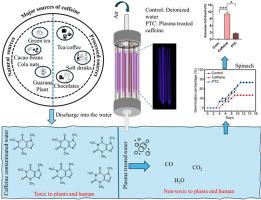通过圆柱形介质阻挡放电等离子体增强咖啡因水溶液的降解:功效和毒性分析。
IF 8.1
2区 环境科学与生态学
Q1 ENVIRONMENTAL SCIENCES
引用次数: 0
摘要
本研究利用圆柱形介质阻挡放电(CDBD)等离子体探索了一种环境友好型咖啡因降解方法。通过电学和光学表征,分别评估了 CDBD 的电流电压特性和等离子体参数,如电子温度、电子密度、氮激发态密度、振动温度和旋转温度。傅立叶变换红外光谱(FTIR)用于评估经等离子体处理的空气中的活性氧和氮物种(RONS)。此外,还测量了去离子水(DW)的理化性质。为了更深入地了解 RONS 在咖啡因降解过程中的作用,对其在去离子水中的浓度进行了分析。此外,还研究了初始浓度、样品量和 pH 值对咖啡因降解的影响。当初始浓度为 50 mg L-1、样品量为 50 mL 且 pH 值为中性时,咖啡因的降解率最高,达到 94%。随后,利用液相色谱-质谱法(LC-MS)提出了咖啡因的降解途径。参与咖啡因降解的主要活性物种是臭氧。最后,对咖啡因在等离子处理前后的植物毒性和细胞毒性进行了评估,结果表明等离子处理咖啡因(PTC)对植物和细胞的毒性都很小。本文章由计算机程序翻译,如有差异,请以英文原文为准。

Enhanced degradation of aqueous caffeine via cylindrical dielectric barrier discharge plasma: Efficacy and toxicity insights
An environmentally friendly approach for caffeine degradation was explored in this study utilizing cylindrical dielectric barrier discharge (CDBD) plasma. The current-voltage characteristics and the plasma parameters of the CDBD, such as the electron temperature, electron density, density of nitrogen excited states, vibrational temperature, and rotational temperature, were assessed through electrical and optical characterization respectively. Fourier-transform infrared spectroscopy (FTIR) was employed to evaluate the reactive oxygen and nitrogen species (RONS) in the plasma-treated air. The physicochemical properties of deionized water (DW) were measured. To gain a deeper insight into the role of RONS in caffeine degradation, their concentrations in DW were analyzed. Furthermore, the effects of initial concentration, sample volume, and pH on caffeine degradation were investigated. The highest degradation of caffeine was 94% at initial concentration of 50 mg L−1, sample volume 50 mL and in neutral pH. Liquid chromatography–mass spectrometry (LC-MS) was then used to propose the degradation pathway for caffeine. The major reactive species involved in caffeine degradation was ozone. Finally, the phytotoxicity and cytotoxicity of caffeine were assessed before and after plasma treatment with plasma-treated caffeine (PTC) showing minimal toxicity to both plants and cells.
求助全文
通过发布文献求助,成功后即可免费获取论文全文。
去求助
来源期刊

Chemosphere
环境科学-环境科学
CiteScore
15.80
自引率
8.00%
发文量
4975
审稿时长
3.4 months
期刊介绍:
Chemosphere, being an international multidisciplinary journal, is dedicated to publishing original communications and review articles on chemicals in the environment. The scope covers a wide range of topics, including the identification, quantification, behavior, fate, toxicology, treatment, and remediation of chemicals in the bio-, hydro-, litho-, and atmosphere, ensuring the broad dissemination of research in this field.
 求助内容:
求助内容: 应助结果提醒方式:
应助结果提醒方式:


